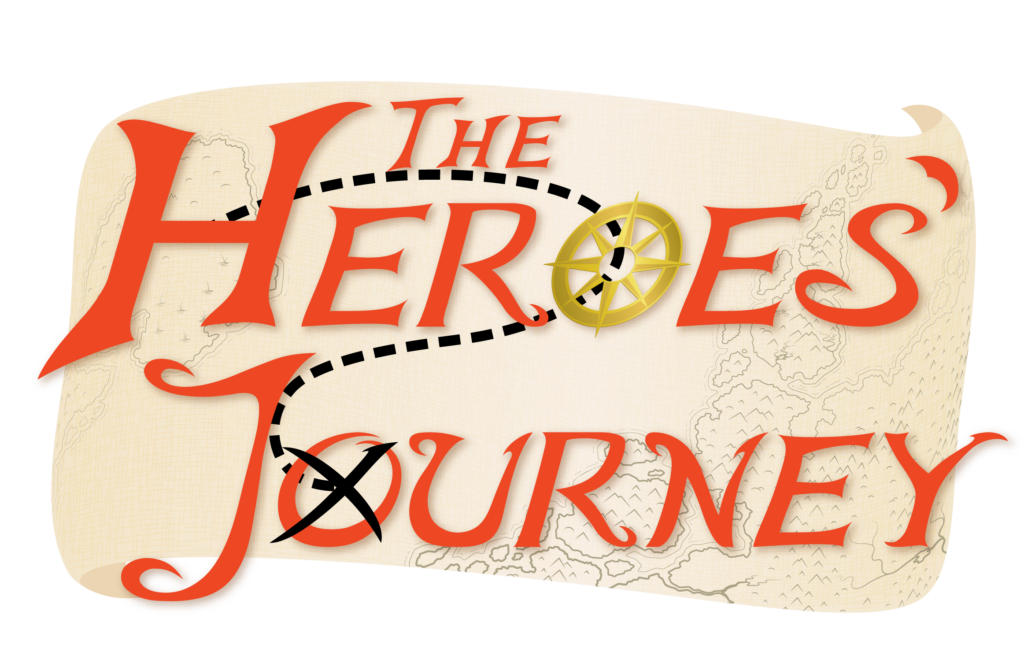
FULL GAME RULES
Turn Structure
Game Set Up
Players will need at least two sets of tokens/dice/whatever to represent various things through the game. Black and red are the most common ones to use but you can utilize any color so long as the distinctions are clear to all players.
Each player will bring two decks to the table:
- An "Atlas" which consists of their chosen Quest-Need and 9 site cards. (This is not shuffled.)
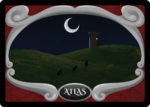
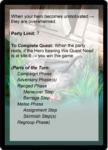
(the cards have backs labeled "atlas" and game text) - A "Book" which consists of an equal number of both campaign cards and adversary cards. (Minimum of 30 on both sides for 60 cards total.) These cards all have a back that looks like this:
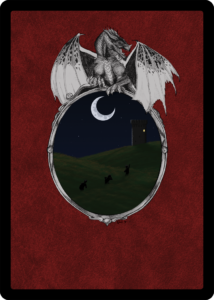
Players take a handful of burden tokens (usually black) and select an amount to be their "bid." Once all players have indicated they are ready, they will then reveal their bids simultaneously. The highest bidder gets to choose their place in the turn order first followed by the second highest bidder and so on. If there is a tie among bids, decide via a mutually agreed method of randomization (coin flip, die roll, etc).
Once everyone is seated around the table, the player going first in turn order will select a site 1 from their atlas. Sites have a range listed in their top left corner denoting where they can be placed in the adventure path. So sites which can be placed as site 1 will have "1-3" in their top left corner.

Once the first player has placed their site 1, each player will then place a marker to represent their party onto the site. (This can be literally anything, as long as it's clear which marker is for which player.)
In player order, each player will then Hero and attach the appropriate Quest-Need (as listed in the Hero's text) from their atlas. Then players may add additional companions from their book to their STARTING PARTY as long as they do not have the "Hero" keyword and total risk cost of all of their starting companions does not exceed 4. (So if your hero costs 4, you cannot play additional companions unless they cost 0.) Any additional "To Play:" costs on the cards must also be paid at this time.
Players then shuffle their book and draw a starting hand of 8 cards. In player order, each player may choose to mulligan if they wish.
Mulligan Rule:
You may choose to hold up to 2 cards. Set aside the rest of your hand.
Draw 6 new cards.
Shuffle the cards you set aside back into your book.
You may repeat this process two additional times, with the number of new cards you draw decreasing by 2 each time.
Optionally the players may then chant: "FIRST TO FINISH, LAST TO FALL!"
The Dichotomy
The most important concept to the Heroes’ Journey is that each card in your book belongs to one of two sides. In the top left corner, around a number representing a cost, will be either a grey circle for a CAMPAIGN card or a black diamond for an ADVERSARY card.
The side a card belongs to denotes the turns it can be played. During your turn you are the PROTAGONIST and can play your CAMPAIGN cards to help your hero on their journey. When it is your opponents’ turn, you are an ANTAGONIST and will then play your ADVERSARY cards to hinder your opponents’ heroes.
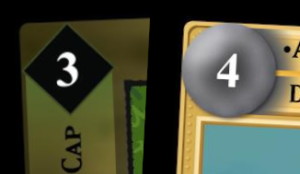
Cultures
In addition to belonging to the campaign or adversary side of your deck, each card also has a specific CULTURE it belongs to. A card's culture is the icon in the upper-right corner of the card. You don't have to worry about memorizing the names of each culture, in game text cultures are always referred to by their symbol. The cultures which appear in the first wave are...
Campaign Cultures
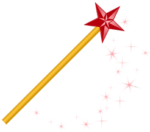 Good Witch
Good Witch
 Ithaka
Ithaka
 Myrmidon
Myrmidon
 Mykenaian
Mykenaian
 Oz
Oz
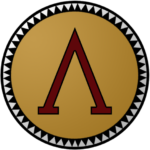 Sparta
Sparta
Adversary Cultures
 Troy
Troy
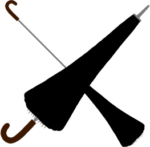 Wicked Witch
Wicked Witch
Phases of a Turn
- CAMPAIGN PHASE
- ADVERSARY PHASE
- RANGED PHASE
- Maneuver Step
- Barrage Step
- MELEE PHASE
- Assignment Step
- Skirmish Step(s)
- REGROUP PHASE
CAMPAIGN phase
The first phase of the turn, the current player – the PROTAGONIST – plays their Campaign cards.
ADVERSARY phase
The second phase of the turn, the other player(s) - the ANTAGONIST(s) - plays their Adversary cards.
The Event Exception
Most cards are played during the campaign phase or adversary phase of the turn. The exception are event cards.
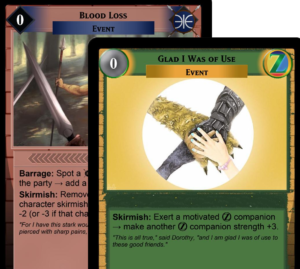
Event cards you save in your hand until the part of the turn listed in their gametext. (It will be bolded followed by a ':'.) If multiple phases of the turn are listed in their game text, then you may play that event during any of those phases, with the appropriate effect happening at that time.
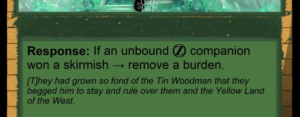
Different from most events are events with "Response:" in their game text. These events can be played at any time whenever their listed conditions occur.
(Note you are still limited to only playing campaign events while you are the Protagonist, and only adversary events while you are an Antagonist.)
The CAMPAIGN Phase
PLAYING CARDS
This is the first phase of the turn and is where the Protagonist plays campaign cards.
When you play a campaign card, you ADD a number of risk tokens equal to its cost from the supply to the center of the table in a RISK POOL. You must also fulfill any “To Play:” requirements on a card.

In this example, when you play this card in addition to its risk cost, you must add burden tokens to your party's BURDEN pool. (Typically represented by black tokens kept in a space between the party and the support area.)
To SPOT something means the card is in play and ACTIVE. While you are the Protagonist, your Campaign cards are active, your opponents’ Campaign cards are inactive. (Imagine they are turned facedown or otherwise not in play.) In this example, to get a discount on the burdens added you must have another Oz culture companion in play – you cannot spot one of your opponents’ Oz companions.
![]()
In this example, to EXERT a character means to place a wound token (usually red) on that character to represent physical effort. You cannot exert a character with 1 health. If all of your Oz companions have only 1 health, this card cannot be played.
Your COMPANION cards are all placed in the same line as your hero and starting companions to represent the PARTY that is helping the hero. Note that if a card has a • in front of its name this means the card is UNIQUE. You cannot play another copy of a unique card that is active and in play or in your grave. However, during the campaign phase if you have a unique companion who is wounded, you may discard a copy of that character from your hand to give them a SECOND WIND – removing 1 wound token from that character.
PLAYING CARDS CONT.
There are also cards which can aid your companions on their journey which are conditions, artifacts, and possessions.
To play these cards, after you have added the appropriate amount of risk to the pool equal to their risk cost, if the card has "-- Support Area" on it's type line then it plays to your SUPPORT AREA - an area of the field behind your main party line.

If the card otherwise says in its text "Bearer must be..." then that card is played onto the target indicated.
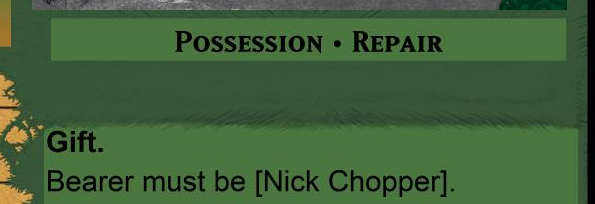
Example: This card plays on a companion named Nick Chopper.
These cards typically have a • after their type followed by a CLASS. A character is allowed to bear only one class of item regardless of its card type.

Example: while you can play this card on any Achaian companion, they must not already be bearing a Hand Weapon.
MOVING YOUR PARTY
Once the Protagonist has played all the cards they wish, they will then MOVE their party's token to the next site.
If there is no site present on the ADVENTURE PATH for the party to move to, the Protagonist will then look at the arrow at the bottom center of the current site and choose the Antagonist sitting to that immediate direction of the arrow. That player will then look through their atlas and select the next site that could be placed in that position and place it onto the adventure path. (i.e. A site with a number "4-6" cannot be placed if the party is moving to the 3rd site on the adventure path.) That site will then gain the number of its position on the path.
The Protagonist then moves their party marker to the next site and adds risk to the pool equal to the risk number in the site’s top right corner + 1 token for each companion in the party.
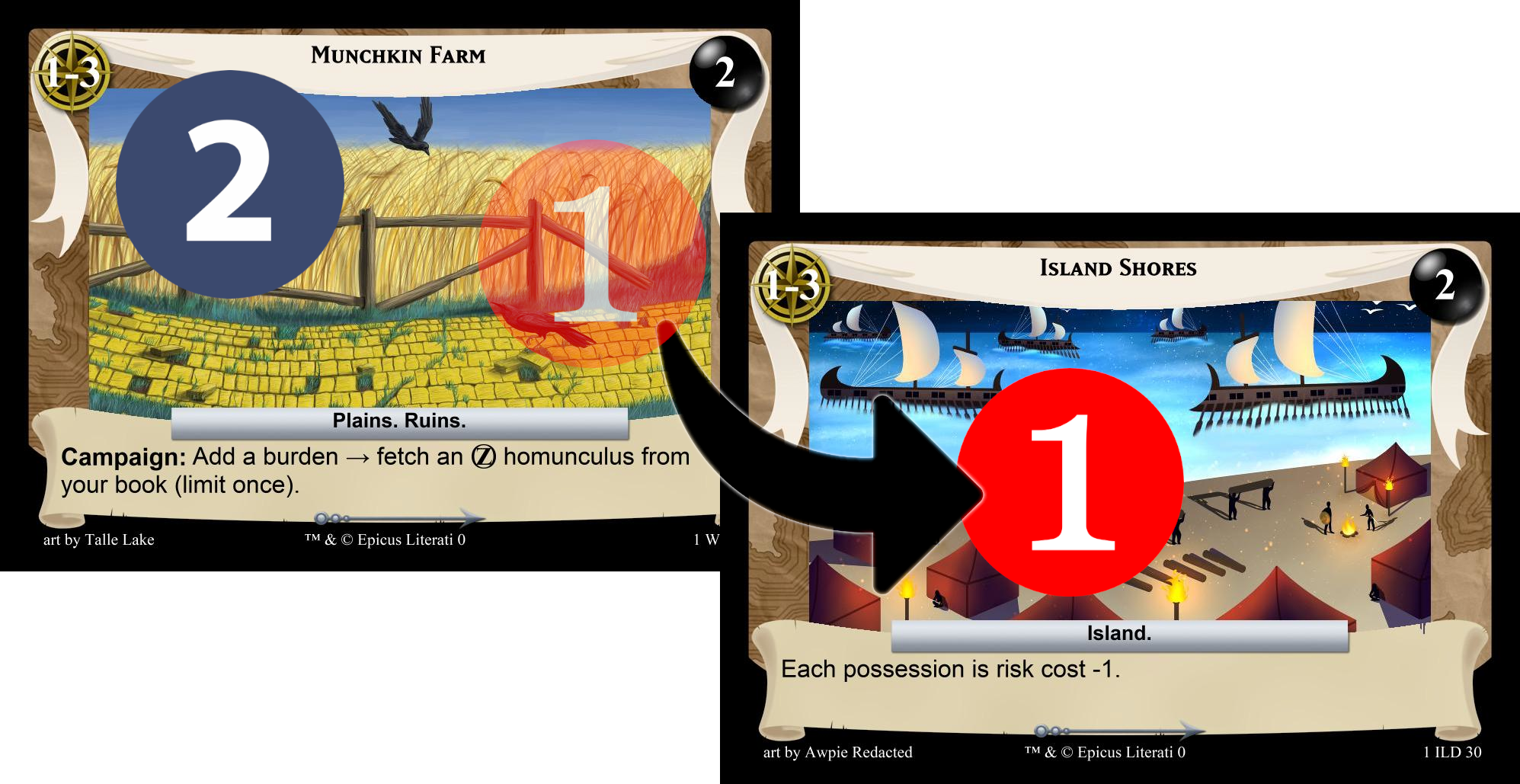
The ADVERSARY Phase
Once the Protagonist has moved, the turn proceeds to the ADVERSARY phase where each Antagonist player gets an opportunity to perform "Adversary:" actions and play adversary cards. Starting with the player to the right of the Protagonist, they may perform an ACTION or PLAY a card or PASS. Then proceeding counter-clockwise around the table the next Antagonist has an opportunity to perform an action, play a card, or pass. Play proceeds in this manner around the table until all Antagonists have consecutively passed. (During this phase the Protagonist does NOT get to perform any actions or play any cards unless they are "Response:" cards/actions.)
When you play an Adversary card, you must REMOVE a number of tokens from the risk pool equal to its cost. If there are not enough risk tokens available, you cannot play your card.
MINIONS are character cards belonging to the adversary side and are used to attack the party. They are played across from the Protagonist's companions (in as menacingly a manner as possible). Adversary cards with "Support Area" on their type line are played to that Antagonist's support area.
Note that minion cards have a number in a symbol identical to the site symbol under their strength and health value.
This is a minion’s home site. If the site you are playing a minion to has a number lower than that minion’s home site, you must pay a ROAMING PENALTY cost of +2 additional risk.

(Example: This minion with a home site of 5 would cost +2 risk if played to sites 2, 3, or 4.)
Once all Antagonists have consecutively passed on playing a card or performing an action, the turn proceeds to the ranged phase.
Unless there are no minions on the field. If at the end of any phase or step there are no minions on the field, the turn proceeds immediately to the regroup phase.
EXAMPLE TABLE
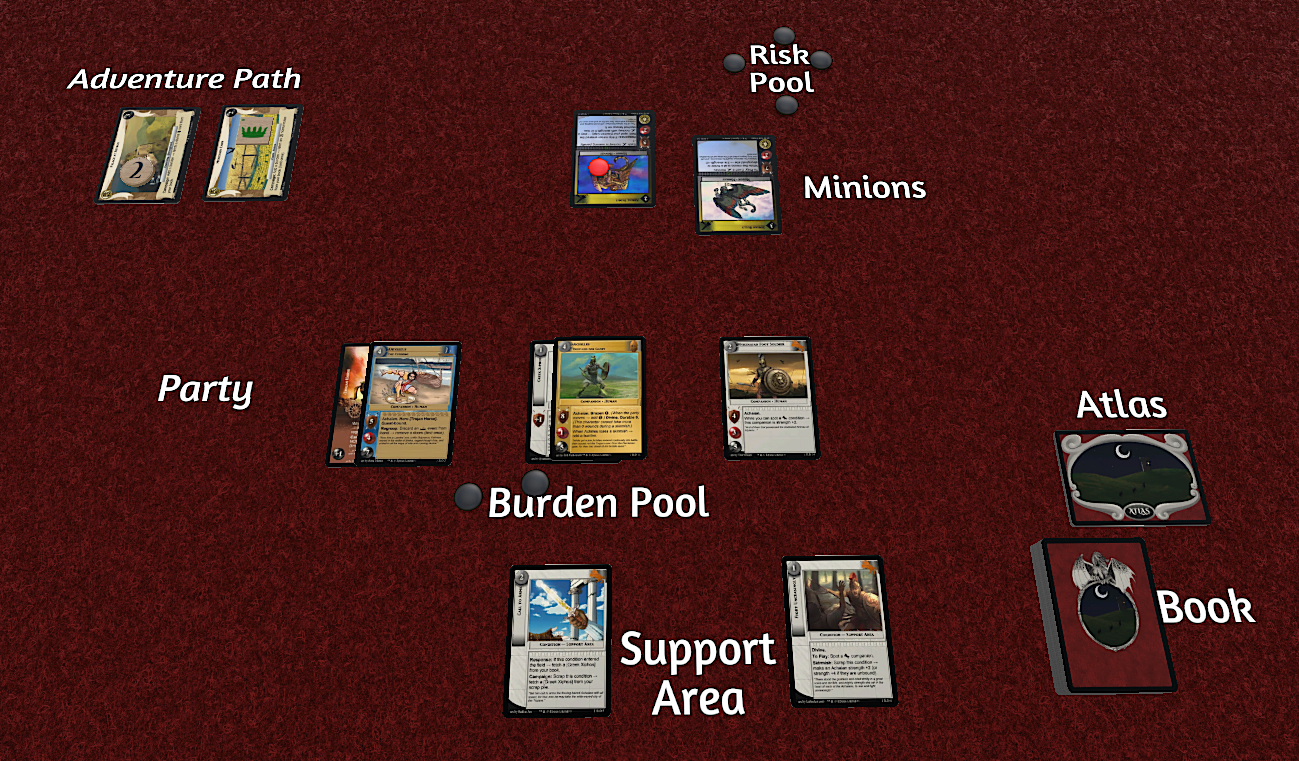
The RANGED Phase
The ranged phase is subdivided into two steps.
Maneuver Step
First is the MANEUVER STEP.
Nothing innately occurs during this step though there might be events and special abilities on cards which reference as happening during this step.
Starting with the Protagonist than proceeding to the Antagonist on their right and so on counter-clockwise around the table, each player has an opportunity to take an ACTION or PASS. (This is called "The Action Procedure.") An action which can be performed during this step will be labeled "Maneuver:"
Unless it is otherwise labeled, an action performed will only affect the game during its current step or phase and then expire.
Once ALL PLAYERS PASS CONSECUTIVELY, proceed to the barrage step. (Unless there are no minions in play. In that case proceed directly to the regroup phase.)
Barrage Step
Once all players have passed in the maneuver step, the turn proceeds to the BARRAGE STEP.
Like in the maneuver step, starting with the Protagonist then proceeding counter-clockwise around the table, each player may take an ACTION with the "Barrage:" label or PASS.
Once all players have consecutively passed, players then calculate ranged totals. Each companion with "Shoot +X" adds +X to the party ranged total while each minion with "Shoot +X" adds +X to the minion ranged total. (There is only 1 minion ranged total no matter how many Antagonists there are or who controls the minions.) Both sides add up all their shoot values as well as any other effects or actions which have been taken to affect their side's final ranged total. (By default, both sides have a ranged total of 0. Any negative values are rounded up to 0.)
Then the Protagonist takes the final minion ranged total and deals X wounds to their party equal to that total. Then the Protagonist selects an Antagonist who must then deal X wounds to the minions they control equal to the party ranged total.
No character can be dealt more wounds than they have remaining health. Once the ranged totals have been distributed as wounds, the turn proceeds to the melee phase.
The MELEE Phase
The melee phase is subdivided into two steps.
Assignment Step
First is the ASSIGNMENT STEP.
Like in the previous steps, starting with the Protagonist then proceeding counter-clockwise around the table, each player may take an ACTION with the "Assignment:" label or PASS.
Most assignment actions result in assigning a minion to a companion. If it does BOTH the minion and the companion must be unassigned, otherwise the action cannot be performed and fails.
Once all players consecutively pass, the Protagonist then takes the minions on the field which remain unassigned and assigns them to skirmish a companion. Each companion may only be assigned to skirmish 1 minion at a time.
If a companion has the "Defender +X" keyword, then +X additional minions may be assigned to that companion if the Protagonist wishes.
Once all companions have been assigned (or the Protagonist declines to assign any more), if any minions remain unassigned, in counter-clockwise order each Antagonist player that controls an unassigned minions may assign those minions to skirmish any companions they wish (even if this results in a companion assigned to fight more than one minion).
Once all Antagonists have assigned the minions they wish, the turn proceeds to the Skirmish Step(s).
Skirmish Step(s)
Once assignments are complete, the Protagonist then chooses the order skirmishes resolve. Each companion participates in its own skirmish step.
When the Protagonist has chosen an assigned companion, they have the first opportunity to perform a "Skirmish:" ACTION or PASS. Then each Antagonist proceeding counter-clockwise around the table has an opportunity to also perform a skirmish action or pass (even if they don't have a minion participating.)
Once all players have consecutively passed, proceed to the skirmish's resolution.
Compare the companion’s strength value along with any modifications from actions with the strength of the minion assigned to them along with any modifications to it. If more than one minion is participating, add all of their strengths together.
The side with the higher strength value wins the skirmish. In case of a tie, the minion side wins.
(Reminder: any bonuses and increases to a character's strength during a skirmish expire when the skirmish resolves.)
RESULTS OF A SKIRMISH
After all players have passed, calculate the final total of both sides’ strength.
- If one side’s total is DOUBLE OR MORE than the other’s total, the losing side is OVERWHELMED. All losing characters are killed regardless of how much health they have.
- If one side has a total GREATER than the other without overwhelming, each losing character receives ONE WOUND. If the winning character(s) have the “Damage +X” keyword then X additional wounds are dealt to the loser(s). (A character that receives wounds equal to or exceeding their health is killed.)
- If both sides are tied, the minions wins.
Place killed minions in their owner’s scrap pile. Place killed companions in their owner’s GRAVE – a pile of cards separate from the scrap pile. Survivors of the skirmish are set aside and now considered “unassigned.”
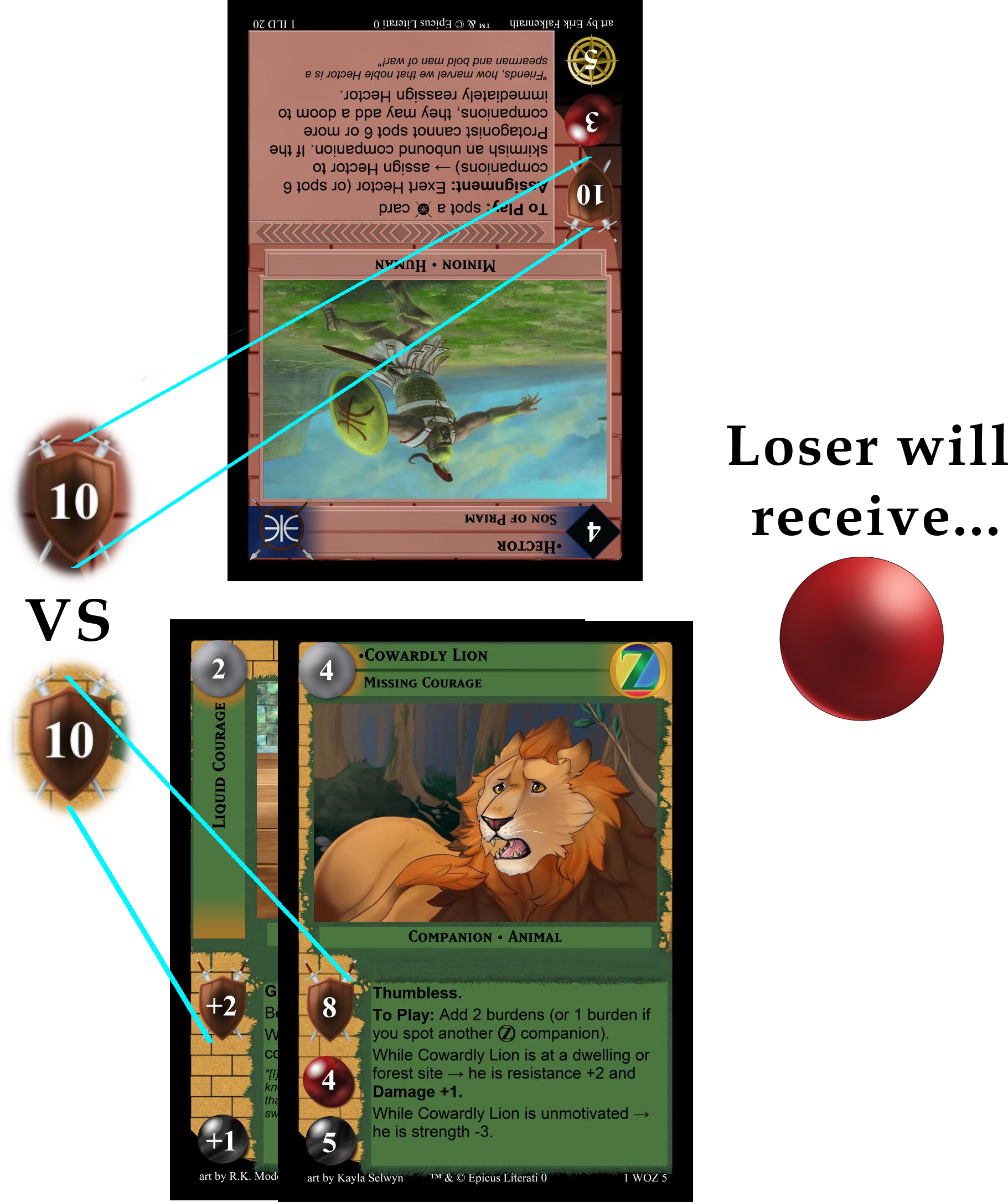
Once a skirmish step is concluded and the consequences dealt out, the Protagonist then chooses another assigned group and repeats the above procedure.
Thus depending on the number of minions, there may be several skirmish steps during a turn. Each one is considered it's own separate skirmish step.
The REGROUP Phase
The last phase of the turn is the REGROUP phase.
Like in the previous steps, starting with the Protagonist then proceeding counter-clockwise around the table, each player may take an ACTION with the "Regroup:" label or PASS.
Once all players have consecutively passed...
Antagonist(s) Reconciles
Each Antagonist RECONCILES their hand simultaneously by doing the following:
- That player may discard 1 card from their hand.
- If that player then has more than 8 cards remaining in their hand, they must discard down to 8 cards.
- Otherwise that player draws cards from their book until they have 8 cards in hand.
After all the Antagonists have reconciled...
Protagonist Decides
The Protagonist player then makes a decision:
MOVE AGAIN – In a game of The Heroes Journey, there is a "move limit" which is equal to the number of players who started the game minus 1 (to a minimum of 2). In a 2 and 3 player game, the move limit is 2. In a 4 player game the move limit is 3, etc.
This move limit is how many times the party can move during a turn, counting the first one during the campaign phase. If the move limit then allows, the Protagonist may choose to have their party move again during the regroup phase. If they do, use the same move procedure described above. (If there is no site, check which Antagonist places the new site, add risk to the pool, etc.) Then the turn goes back to the adversary phase and each Antagonist now has a new opportunity to play additional adversary cards followed another round of ranged, melee and regroup phases.
REST – If the Protagonist chooses for their party to rest (or must rest because they have already moved a number of times equal to the move limit), then the Protagonist reconciles using the same method the Antagonists used.
Then any minions that are still on the field are placed in their owner’s scrap pile. (Only minions and cards they bear are scrapped - other adversary cards like ones in a player's support area will remain in play, and become inactive when that player becomes the Protagonist.) Then the risk pool is emptied and the next player going clockwise around the table becomes the new Protagonist.
WINNING THE GAME
There are two ways to win the game.
FIRST TO FINISH
Each Quest-Need will list on the back of its card, "To Complete Quest:" along with the requirements needed to do so. (Currently all QNs require reaching site 9.) If you manage to fulfill your QN's requirement before any other player fulfills theirs, then you win the game.
LAST TO FALL
If, at any point while you are the Protagonist, your Quest-Need leaves the field (because your hero has been killed for example), then you immediately lose the game. If all other players have lost, then the last player remaining wins the game.
Deck Building
You may build any deck you wish as long as it fulfills the following criteria.
BOOK - Your book must consists of an equal number of campaign and adversary cards.
- The minimum of campaign cards for a deck is 30 and the minimum of adversary cards for a deck is 30.
- At least 1 of your campaign cards needs to be a companion with the hero keyword capable of bearing your quest need.
ATLAS - Your Atlas is a side deck which must contain at least 1 Quest Need.
- It must also have at least 9 sites, 3 for each region of the site path (1-3, 4-6, 7-9).
Also note that for traditional play, it is recommended to use only black border cards. Golden border cards are for special modes and not intended for regular games.
Game Terms
Here is a reference to many common game terms used in The Heroes' Journey.
-
- Banish – "Out-of-game" zone where cards are placed. By default cards that have been banished are public knowledge and can be examined by any player at any time.
- Book – Term for your main draw deck of cards shuffled at the start of the game.
- Exert – Place a wound token on a character. You cannot exert a character with 1 health.
- Fetch – Look through a pile of cards for a card indicated. Select any of the indicated cards, reveal those cards to the rest of the table, and then add them to your hand. If you look through your book in this manner, shuffle it afterwards.
- Field – Term for the “in play” game area.
- Scrap – Move a card from the field to its owner’s scrap pile.
- Spot – Have a card (or cards) with the specified features on the field and active. Cards which are inactive or in a zone other than the field cannot be spotted.
Loaded Keywords
The following are a list of keywords used in the game which have built in rules associated with them. Note that on cards, keywords are always separated by a period.
-
- Brazen (X). - When the party moves → add (X) risk to the risk pool.
- Damage +X. – When this character wins a skirmish → deal +X additional wounds to the losing character(s).
- Defender +X. – The Protagonist may assign +X additional minion to skirmish this companion.
- Durable X. - This character cannot receive more than X wounds during each skirmish step.
- Hero [ ]. – Loaded keyword which means, “This companion can be your party’s hero, bearing the Quest-need listed in the brackets.”
- Indomitable. - This character is not overwhelmed during a skirmish unless the winning side has triple its combat value.
- Quest-bound. – A character without the quest-bound keyword is "unbound."
- Sanctuary X. – When the campaign phase begins, the Protagonist may remove up to X total wounds from their party at this site. (Note that while not regularly marked, it is a rule in the game that sites 3 and 6 gain the "Sanctuary 5." keyword when placed.)
- Shoot +X. - This character adds +X to its side's ranged total.
- Thumbless. – This character cannot bear any artifacts or possessions.
If a keyword is not listed above, then it is unloaded. There are no rules associated with it, but other cards and their text will reference or care about it.